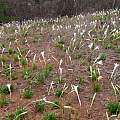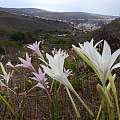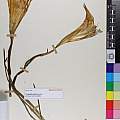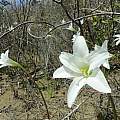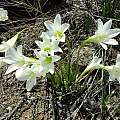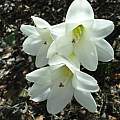Tocantinia is a genus in the family Amaryllidaceae. This genus was named by P.F. Ravenna in 2000 for one species found in Brazil. Phylogenetic studies based on molecular characters place Tocantinia in the tribe Hippeastreae, subtribe Hippeastrinae. This bulbous genus is endemic to Brazil and grows in in chemically poor, shallow and sandy soils from the Cerrado Biome. Flowering occurs after a rainfall that marks the beginning of the rainy season and lasts about two to three days once a year some time from November to January. Bulbs produce one flower that opens at the end of an afternoon, opens fully in the early evening and closes in the middle of the next morning. Flowers are white, fragrant, and probably pollinated by moths or bats. Because this genus is rare and flowering occurs so briefly it is difficult to find and not widely known. Henrique Mallmann Büneker, Regis Eduardo Bastian, Kelen Pureza Soares, and Calmito Miranda Costa in their paper written in 2016 The Genus Tocantinia (Amaryllidaceae, Amaryllidoideae) and Two New Species from Brazil have proposed two new species. Information and photographs on this page were taken from that paper with permission of the authors. Tocantins (meaning toucan's beak) is the name of a river and state in Brazil in the area these species come from. Some botanists think that this genus isn't appropriate (i.e. shouldn't be accepted) because some members appear to be natural hybrids with Hippeastrum. We have included it here for completeness.
Tocantinia dutilhiana Büneker, R. Bastian & C. Costa, sp. nov. occurs in the Espinhaço Mountain Range, in the central region of Minas Gerais state and in southwestern Bahia state. It differs from T. mira by different ovules, a longer scape, two bracts instead of one, shorter tepals and a three lobed stigma. It differs from T. stigmovittata by having a shorter scape, yellowish external coloration on the upper portion during blooming, shorter tepals, and a completely white stigma when the flowers are fully open. Photos 1 and 2 of population in habitat by Exupério Ledo Silva.
Tocantinia mira Ravenna is known only by the type collection, whose specimens are from a collection of a natural population at the locality in Rio Lajes, southeast of the Tocantins state (Brazil). The original population of the collection was not located and other populations have not been found in habitat. Photo of holotype of the species.
Tocantinia stigmovittata Büneker, R. Bastian & C. Costa, sp. nov is only known from one population in the central region of Espinhaço Mountain Range in the southwestern Bahia state. It differs from T. mira by different ovules, wider leaves and a longer scape, more bracts (2-3 versus 1), and a three lobed stigma. It differs from T. dutilhiana by having a longer scape, greenish versus yellowish external coloration on upper portion of the flower, longer tepals, and the margins of the stigma when the flowers are fully open are pink. Photos 1 to 3 from Büneker, R. Bastian and C. Costa.
